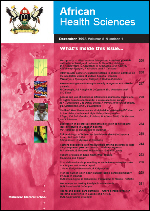
|
African Health Sciences
Makerere University Medical School
ISSN: 1680-6905
EISSN: 1680-6905
Vol. 19, No. 4, 2019, pp. 2954-2963
|
 Bioline Code: hs19162
Bioline Code: hs19162
Full paper language: English
Document type: Study
Document available free of charge
|
|
|
African Health Sciences, Vol. 19, No. 4, 2019, pp. 2954-2963
| en |
Effect of removal of AuraOnceTM laryngeal mask in awake or deep anaesthesia: a randomized controlled trial
Ombaka, Ronald; Mung’ayi, Vitalis; Nekyon, David & Mir, Samina
Abstract
Background: The manufacturer Ambu® recommends that the AuraOnce™ laryngeal mask be removed once the patient is
fully awake. Studies have shown benefit in removal of the laryngeal mask airway while a patient is deeply anaesthetized. Current
evidence is inconclusive, as to which approach is preferable and safer in adults.
Methods: one hundred and sixteen adult patients were randomly assigned to two groups of 58. For the deep arm; The AuraOnceTM
laryngeal mask was removed after attaining an end tidal minimum alveolar concentration of Isoflurane of 1.15%.
Occurrence of airway complication(s) (One or more of the following; Airway obstruction requiring airway manipulation; Laryngospasm;
Desaturation to 90% or less on pulse oximetry) was noted until the subject was fully awake (appropriate response
to command) in the post-anaesthesia care unit. For the awake arm; The AuraOnceTM laryngeal mask was removed on attaining
an end tidal minimum alveolar concentration of Isoflurane of <0.5% and an appropriate response to command or obtaining
appropriate response to command irrespective of end tidal concentration. Occurrence of airway complication(s) in theatre and
post anaesthesia care unit was recorded. Time to theatre exit was recorded for both groups.
Results: Baseline demographic characteristics were similar between the groups. More airway complications were encountered
in the Deep arm - 13 (22.4%) relative to the Awake arm -5 (8.6%), this was found to be statistically and clinically significant, P
value P=0.040, odds ratio 3.0622; 95% CI, 1.0139 to 9.2483.
Conclusion: The removal of the AuraOnceTM laryngeal mask while the patient is still deeply anaesthetised is not as safe as or
safer than awake removal.
Keywords
AuraOnceTM laryngeal mask; deep anaesthesia.
|
| |
© Copyright 2019 - Ombaka et al.
|
|
